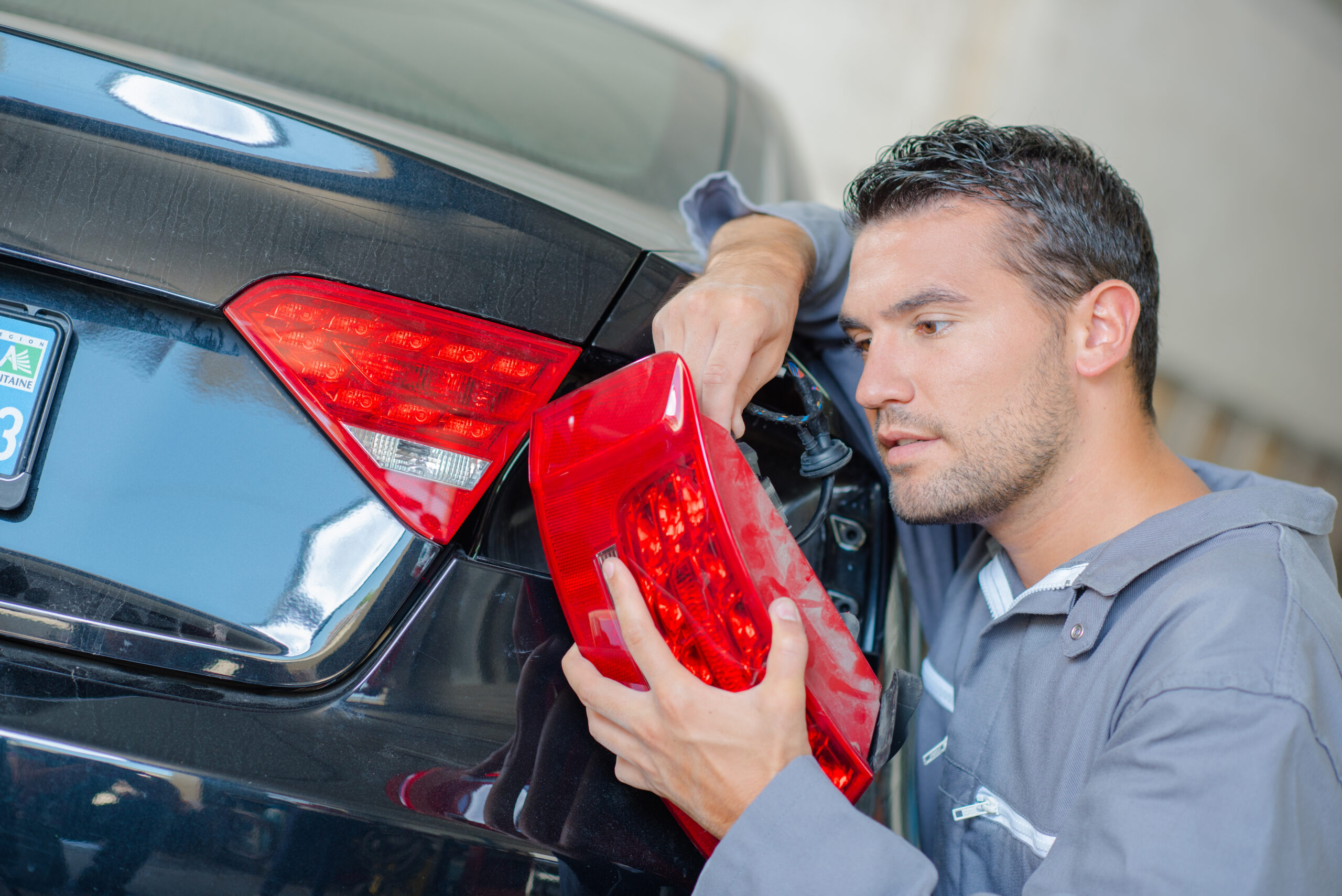Is it Illegal to Drive with a Broken Tail Light?

A Broken Tail Light
We’ve probably all been there at some point. You are driving along, minding your business, and you see flashing red lights behind you. You may consider what you have done wrong to get pulled over, speeding, no traffic signal, or more.
What if you have a broken tail light? This issue may be enough reason for cops to pull you over and issue you a fine. The answer isn’t always black-and-white, as some research shows that even if it is broken but taped back together and emitting a red glow, you are safe from getting a fine.
Red Vs. White Light on Tail Lights
One of the single most essential protections from rear-end collisions is to have operational tail lights. If you have a broken tail light, there is a chance that the light reflecting is now more white than red. If you can use something to tape the cover back together accurately so that the red light is emitting, this may be enough to suffice until you can get it fixed.

If primarily white or all white is showing through the broken cover, you may subject yourself to getting pulled over or fined. The reason for this is that the red indicates that you are stopping, while if only white is showing, others behind you may not realize that you are braking, and therefore, you are a hazard to others on the road.
Other Hazards of Broken Tail Lights
Another safety concern with a broken tail light can be that if water gets into the fixture due to the fractured cover, this can cause a short. A short in your car’s system could lead to other operational malfunctions, which can be a safety concern.
It’s also important to note that if the cover is broken and pieces are coming loose from your car while you are driving and hitting windshields behind you, this could be a safety concern and cause others to become distracted and cause an accident.
Due to these reasons, and the red light not being omitted as efficiently, you may be pulled over and asked to fix the tail lights.
2016 Colorado Revised Statutes
According to chapter 42 of the 2016 Colorado Revised Statutes that cover Vehicles and Traffic Regulations, including tail lamps and 42-4-206 tail lamps and reflectors:
“Every motor vehicle, trailer, semi-trailer, pole trailer and any other vehicle which is being drawn at the end of a train of vehicles shall be equipped with at least one tail lamp mounted on the rear…shall emit a red light plainly visible from a distance of five hundred feet to the rear.”
Again, the red light emitting and plainly visible is the most important part of the sentence, meaning that a white light emitting may mean you get pulled over.
A Temporary Solution
If you can’t get to the body shop immediately and need a temporary fix, you have a few options to consider. If the crack isn’t large, you may be able to use craft glue to ensure the cover is intact.
You may want to purchase lens repair tape if the crack is larger. Clean the area, let it dry, and apply the tape matching the size of the crack in the cover. It’s important to note that you should smooth out any bubbles as this could interfere with the red light emitting properly through the tape.

You may also be able to remove and replace the cover yourself with a kit you can find online. Each car is different, so search your make and model and see what options are available. The process can be relatively simple with a few tools, sometimes provided in the repair kit.
Understanding Tail Light Issues and Legal Implications in Colorado
Tail Light Repair and Replacement Options
Driving with a broken tail light can lead to being pulled over by a police officer, and potentially getting a ticket. In Colorado, the vehicle code requires that tail lights must emit a red light visible from 500 feet. If your tail light cover is cracked or the light bulb is out, it’s essential to address the issue promptly. Temporary solutions like using red lens repair tape can help you avoid fines, but it’s always best to seek a permanent fix. Replacing the tail light cover or the light bulb is often straightforward and can be done with a few tools.
Legal and Safety Considerations
Accident attorneys often deal with cases where non-functioning tail lights have led to rear-end collisions. It’s crucial to understand that swift action to repair tail lights not only keeps you compliant with the law but also ensures the safety of all drivers on the road. Whether you’re driving your car or towing boat trailers, operational tail lights are a key safety feature. Colorado law is strict about vehicle maintenance to prevent accidents and enhance road safety.
Practical Solutions for Tail Light Problems
If you find yourself with a broken tail light, there are several practical solutions available. Many auto parts stores offer tail light repair kits that include everything you need to fix a cracked or broken light cover. These kits are often specific to your vehicle’s make and model, making the repair process easier. Additionally, it’s important to regularly check your vehicle’s tail lights to ensure they’re functioning correctly. Keeping your tail lights in good condition is not just about avoiding tickets; it’s about preventing accidents and ensuring you and other drivers are safe on the road.
By understanding and addressing tail light issues promptly, you can avoid legal trouble and contribute to safer driving conditions for everyone.
Safety First
Most or all regulations are in place to maintain safety for all. Without proper tail lights, you can pose a risk to other drivers, not to mention yourself, from others colliding with you.
Whether a temporary or permanent fix, it’s important to have functioning tail lights. You may subject yourself to the risk of getting pulled over, which is unnecessary for such a minor issue.
As personal injury attorneys, we often help clients who have been the victims of car accidents. Don’t let a small issue become a more significant problem and subject yourself to a personal injury case because your tail light wasn’t functional.
Contact our office today at (720) 707-0870 with any questions. We offer a free initial consultation in which we can discuss what options you have.
FAQs
Is it illegal to drive with one brake light out in Colorado?
Yes, driving with one brake light out is illegal in Colorado. The 2016 Colorado Revised Statutes require vehicles to have functioning tail lights that emit a red light visible from 500 feet. Non-compliance can result in fines and poses a safety risk.
Can you get pulled over for driving a damaged car in Colorado?
Yes, in Colorado, you can be pulled over for driving a damaged car if the damage affects safety features such as tail lights. A broken tail light is sufficient reason for law enforcement to stop you, as it can compromise road safety.
What are temporary tail lights and how are they used in Colorado?
Temporary tail lights are makeshift solutions to ensure your vehicle’s rear lights are visible until you can get a permanent fix. In Colorado, using red lens repair tape or temporary light covers can help you comply with legal requirements and avoid fines while awaiting repairs.
How can I use temporary tail light solutions effectively in Colorado?
To use temporary tail light solutions in Colorado, clean the damaged area, dry it thoroughly, and apply red lens repair tape over the crack. Ensure the tape is smooth and free of bubbles to maintain proper light emission. This temporary fix helps you stay compliant with Colorado’s vehicle regulations.
What is tail light tape and how do I use it in Colorado?
Tail light tape is a special tape used to cover cracks in your tail light cover. In Colorado, to use it effectively, clean the area, let it dry, and apply the tape over the damaged section, ensuring no bubbles obstruct the light. This temporary solution helps maintain compliance with Colorado laws.
Can I drive with a busted tail light in Colorado?
Driving with a busted tail light in Colorado can lead to being pulled over and fined. The law requires tail lights to emit a red light visible from 500 feet. A broken tail light can compromise safety and result in a ticket.
Is a cracked tail light illegal in Colorado?
Yes, a cracked tail light can be illegal in Colorado if it affects the emission of red light. The law mandates that tail lights must be clearly visible from a distance. If a cracked cover emits white light instead of red, it could result in a fine.




